Key takeaways:
- Incorporating rhythm and music into the classroom fosters active participation and enhances engagement, making learning enjoyable and memorable.
- Using instruments and body percussion creates a sense of community among students, allowing for creative expression and emotional connection.
- Establishing routines with music, such as warm-ups or rhythmic exercises, sets a positive tone for the learning environment and helps improve focus.
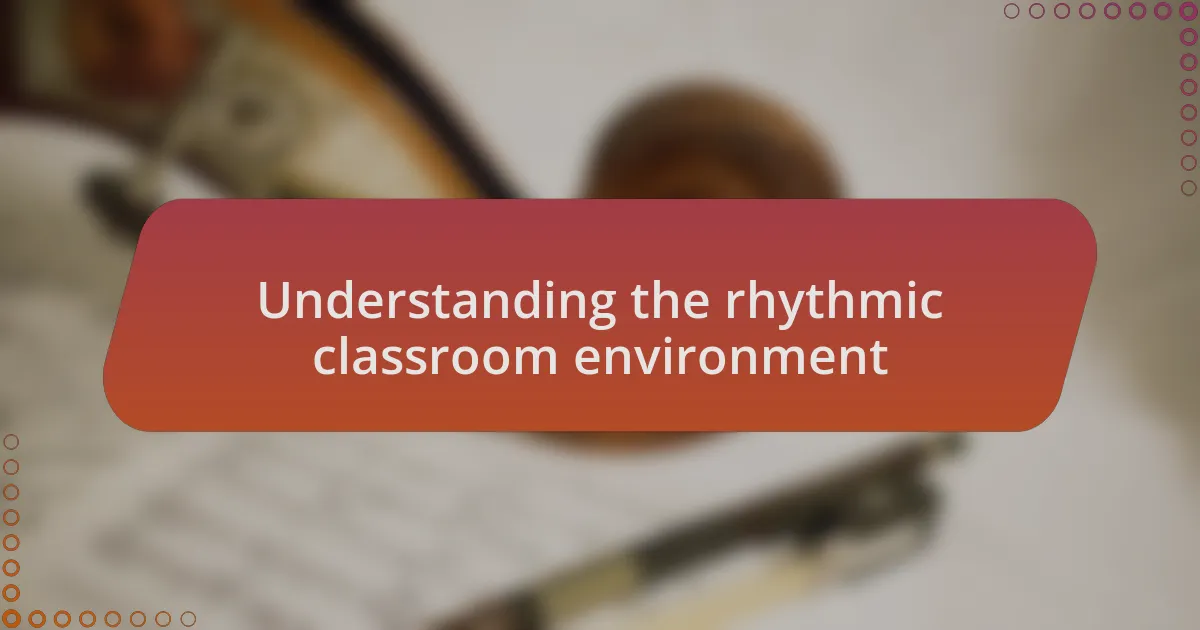
Understanding the rhythmic classroom environment
Creating a rhythmic classroom environment is all about fostering a space where music and movement become integral to learning. I remember the first time I incorporated drumming into my lessons; the room transformed. Suddenly, students were not just passively listening; they were actively participating, their excitement creating a palpable energy that made learning fun.
Rhythm can be found in everyday activities, connecting concepts and enhancing memory retention. Have you ever noticed how children naturally respond to beat? In my experience, clapping or tapping to the rhythm of new vocabulary words can turn a challenging lesson into a playful experience, encouraging students to engage in ways that traditional methods simply don’t achieve.
Understanding this dynamic involves recognizing that rhythm stimulates both emotional and cognitive responses in young learners. I often see students who might struggle to articulate their thoughts, come alive during rhythmic exercises, as if the music has unlocked a part of their creativity. It’s fascinating how a simple beat can give them a voice they didn’t know they had.
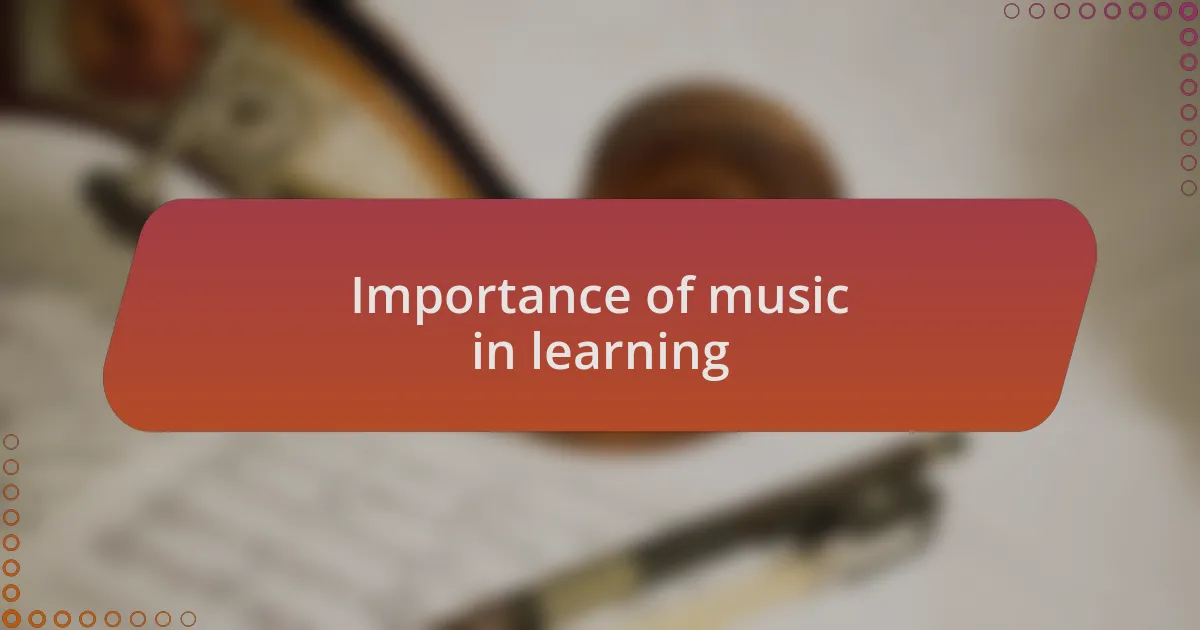
Importance of music in learning
Music plays a pivotal role in learning, acting as a catalyst for engagement and comprehension. I recall a moment when I used a song to teach a complex historical concept; students were singing along, not just memorizing dates, but genuinely understanding the significance of events. Isn’t it incredible how melody can transform information into something memorable?
Beyond mere enjoyment, music helps to improve focus and retention. I have witnessed students who often drifted off during standard lessons become animated and attentive when rhythmic elements entered the room. Have you ever noticed how a catchy tune can stick in your head? That’s the power of music in solidifying learning—once a child associates knowledge with a rhythm, it becomes part of their long-term memory.
Moreover, incorporating music in education nurtures emotional intelligence. I’ve seen firsthand how students with different backgrounds connect through a shared song, breaking down barriers and fostering empathy. Doesn’t that illustrate how music can build community in a learning environment? When children feel connected, they’re more likely to take risks and explore their potential.
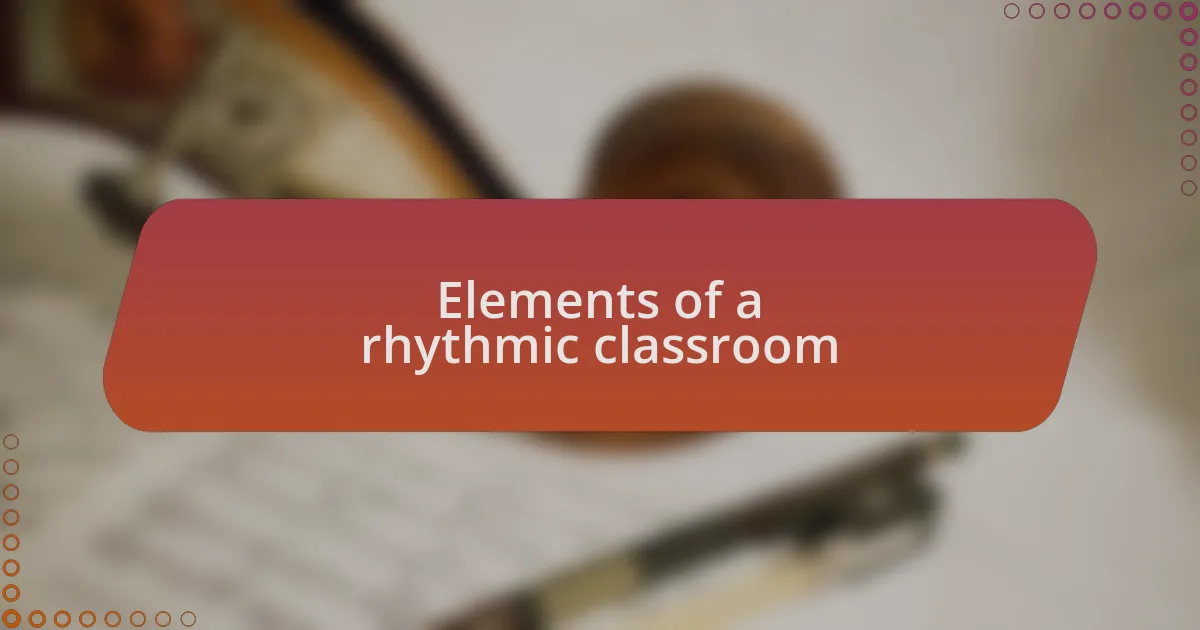
Elements of a rhythmic classroom
Creating a rhythmic classroom environment begins with the integration of various sensory elements. For me, the use of instruments, such as tambourines or hand drums, invites students to engage physically and mentally. I remember when I introduced clapping games alongside lessons; the energy in the room shifted palpably. Students weren’t just listening; they were participants, feeling the rhythm in their own bodies. How can we underestimate the power of our own heartbeat guiding us through learning?
Another essential element involves using visual cues to reinforce rhythm. Simple posters illustrating different musical notes or patterns can ignite curiosity about how sound works. I once displayed a colorful chart of rhythmic values in my classroom, sparking a project where students created their own rhythms. The resulting compositions were stunning. Isn’t it fascinating how a little creativity can turn abstract concepts into tangible experiences?
Lastly, establishing a consistent routine fosters a sense of security and familiarity. I have learned that starting each class with a musical warm-up helps set the tone for what’s to come. One particular morning, after a chaotic start, I played a favorite song, and the students immediately shifted from restless to ready. Don’t you think that even a short musical moment can lay the groundwork for a more focused and productive class?
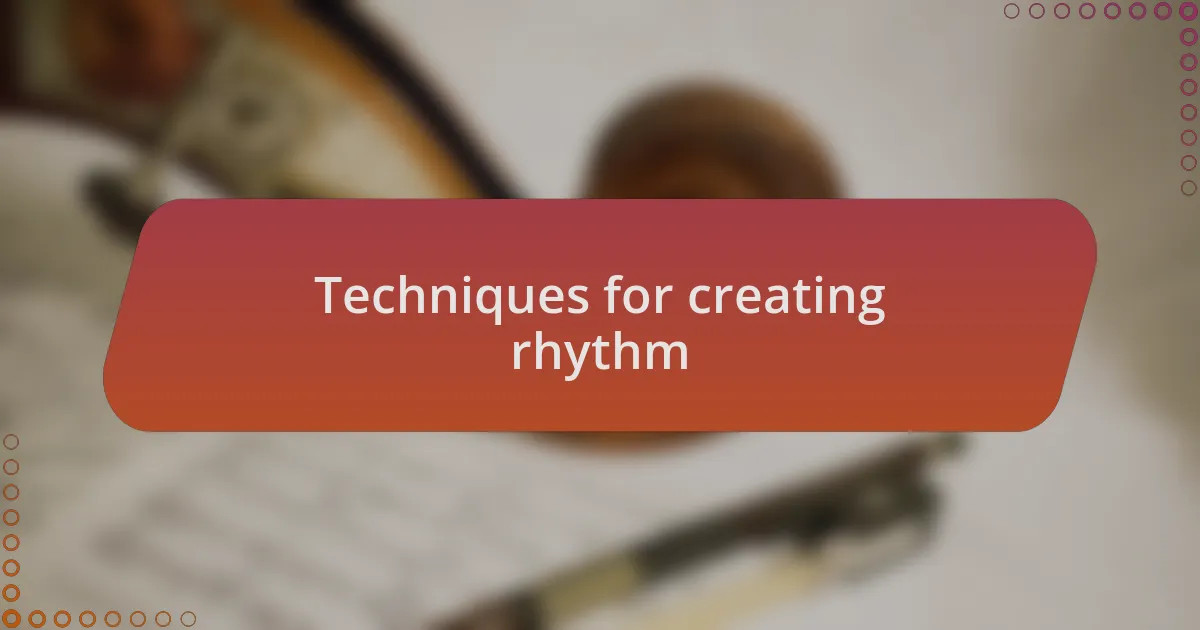
Techniques for creating rhythm
Using body percussion is a powerful technique to create rhythm in the classroom. I recall a session where we explored different sounds by clapping thighs or stomping feet. It was incredible to see how quickly the students connected with each other, synchronizing their movements to form a collective beat. Have you ever noticed how such simple actions can forge a deeper sense of community among young learners?
Another effective approach is incorporating technology, like rhythm apps or digital metronomes. One day, I introduced a metronome to help my students maintain a steady beat during a group activity. The fascination on their faces was priceless as they experimented with varying tempos, transforming the learning environment into an interactive sound lab. Isn’t it amazing how technology can serve as both a tool for education and a source of inspiration?
Finally, I often integrate storytelling with rhythmic elements. During a storytelling session, I allowed students to create sound effects in response to the narrative. I vividly remember a tale about a thunderstorm where my students mimicked the rain and thunder with their voices and instruments. This technique not only deepened their understanding of rhythm but also brought the story to life in a memorable way. Can you imagine how storytelling, enhanced with rhythm, can captivate young minds and nurture their creativity?
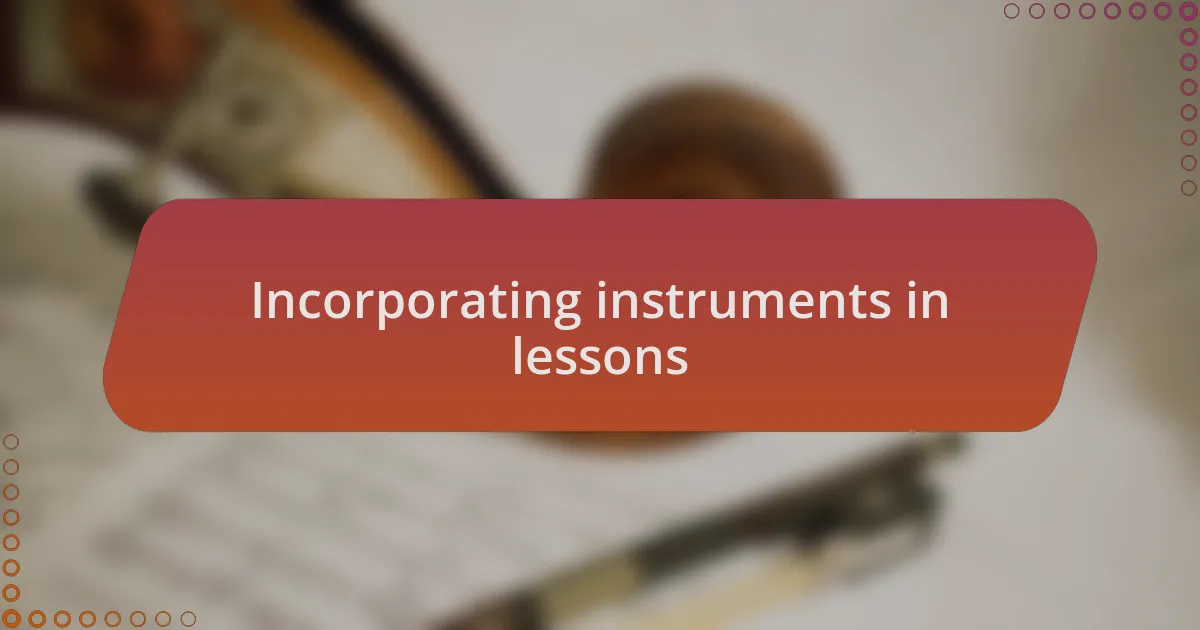
Incorporating instruments in lessons
Incorporating instruments into lessons can significantly enhance students’ engagement and understanding of rhythm. I often bring a variety of percussion instruments into my classroom, such as tambourines and shakers. One memorable experience involved a group of students playing along to a well-known children’s song, where their excitement was palpable as they discovered how their rhythms complemented the melody. Have you noticed how quickly children bond over creating music together?
Sometimes, I set up stations with different instruments and let students rotate through each one. I remember a lively session where they explored everything from maracas to drums, each instrument sparking new energy and creativity. As they played, I encouraged them to express what they felt, leading to conversations about rhythm’s emotional impact. Isn’t it fascinating how music can give voice to feelings that words sometimes can’t?
In my lessons, I also emphasize improvisation, allowing students to experiment with their own rhythm patterns. I vividly recall a moment when a shy child confidently played a complex beat on a djembe, surprising even themselves. The joy on their face as they realized their ability to contribute uniquely made the lesson unforgettable. How often do we overlook the potential for every child to shine through the magic of music?
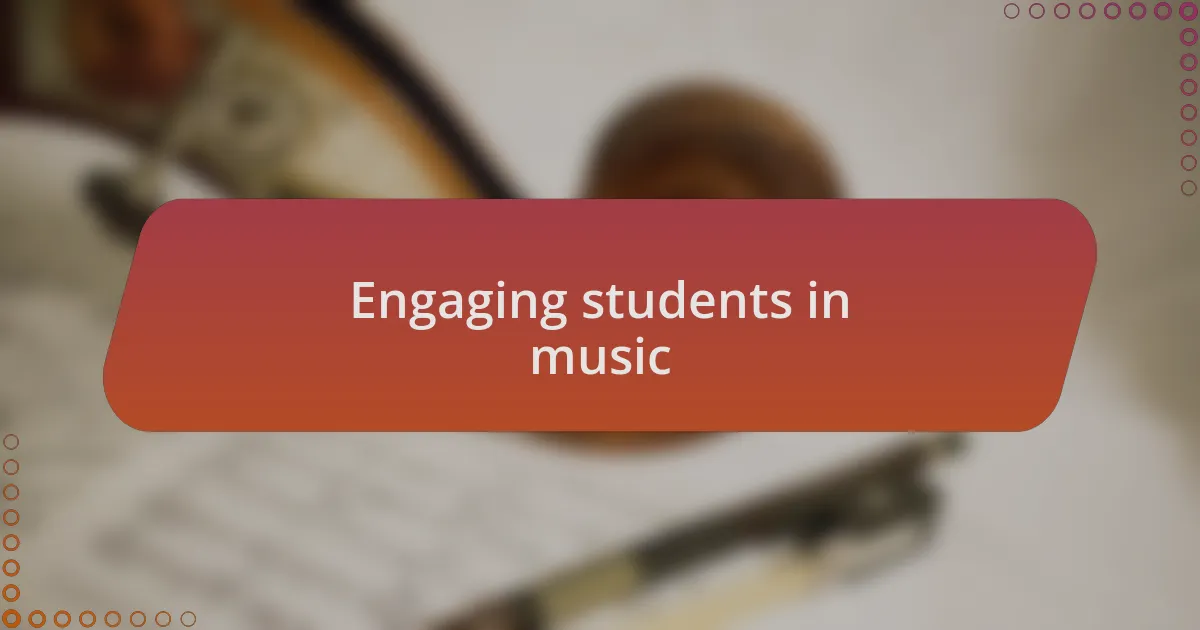
Engaging students in music
Engaging students in music goes beyond just teaching notes; it’s about creating connections. One day, while we were learning a new song, I decided to allow students to suggest movements that mirrored the feelings evoked by the music. Watching them jump, sway, and spin in response to the melody was incredible. It made me realize how physical expression dramatically deepens their understanding of musicality. Isn’t it amazing how movement can enhance our appreciation for sound?
Another effective strategy I’ve found is incorporating storytelling into music lessons. I once told a story that described various animals, encouraging students to match their sounds with instrumental responses. The room filled with roars, chirps, and dances that mimicked the behaviors of each creature, turning an ordinary lesson into a vibrant experience. I ask myself, how can stories breathe life into music, making it more relatable and memorable for our young learners?
I also love using call-and-response techniques during sessions. There was a particular instance when I started a simple rhythm, and the students eagerly echoed back with their unique variations. The spontaneous energy in the room sparked laughter and camaraderie among them. It convinces me that when students actively participate, they not only engage better but also build confidence in their musical abilities. Have you noticed how these interactions create a sense of community, making each class feel like a collaborative performance?

Personal experiences with classroom rhythm
Rhythm has a magical way of transforming a classroom. I vividly remember a day when I introduced a drum circle activity. As we passed around various percussion instruments, the room erupted with different beats, and I could feel the energy shift. The laughter mixed with the rhythms created a palpable sense of joy, reminding me how the act of creating music can forge strong bonds among children.
In my experience, establishing a steady classroom rhythm often starts with simple clapping exercises. There was a time when I organized a clapping game where students had to sync their claps with a metronome. The concentration on their faces, followed by spontaneous giggles when someone clapped out of sync, highlighted how rhythm isn’t just about accuracy; it’s about connection and collaboration. Isn’t it fascinating how such a simple exercise can spark moments of shared joy?
One of my fondest memories involved a spontaneous dance-off based on rhythm patterns we practiced. I encouraged students to create their own rhythms and challenged their peers to interpret them through dance. The laughter and competitive spirit that filled the classroom showcased how rhythm can transcend just music; it becomes a language of expression. I often reflect on how these light-hearted moments reinforce the idea that learning and fun can coexist beautifully in a rhythmic environment.